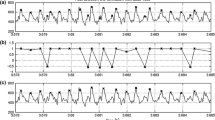Abstract
Quality of sleep is an important attribute of an elder’s health state and its assessment is still a challenge. The sleep pattern is a significant aspect to evaluate the quality of sleep, and how to recognize elder’s sleep pattern is an important issue for elder-care community. With the pressure sensor matrix to monitor the elder’s sleep behavior in bed, this paper presents an unobtrusive sleep postures detection and pattern recognition approaches. Based on the proposed sleep monitoring system, the processing methods of experimental data and the classification algorithms for sleep pattern recognition are also discussed.






Similar content being viewed by others
References
Aaronson ST, Rashed S, Biber MP, Hobson JA (1982) Brain state and body posture: a time-lapse video study of sleep. Arch Gen Psychiatry 39:330–335
Adami AM, Hayes TL, Pavel M, et al. (2005) Detection and classification of movements in bed using load cells. Proceedings of the IEEE 27th Annual International Conference of the Engineering in Medicine and Biology Society, Shanghai, China, Jan 2005, pp 589–592
Breiman L (2001) Random forests. Mach Learning 45:5–32
Cheng CM, Hsu YL, Young CM, Wu CH (2008) Development of a portable device for tele-monitoring of snoring and OSAS symptoms. Telemed e-Health 14:55–68
Foley DJ, Monjan AA, Brown SL et al (1995) Sleep complaints among elderly persons: an epidemiologic study of three communities. Sleep 18:425–432
Foley D, Ancoli-Israel S, Britz P, Walsh J et al (2004) Sleep disturbances, chronic disease in older adults: results of the 2003 National Sleep Foundation Sleep in America Survey. J Psychosom Res 56:497–502
George HJ, Langley P (1995) Estimating continuous distributions in Bayesian classifiers. Proceedings of the 11th Conference on Uncertainty in Artificial Intelligence, San Mateo, pp 338–345
Kaartinen J, Kuhlman I, Peura P (2003) Long-term monitoring of movements in bed and their relation to subjective sleep quality. Sleep Hypn 5:145–153
Kimura H, Kobayashi H, Kawabata K, et al. (2004) Development of an unobtrusive vital signs detection system using conductive fiber sensors. Proceedings of 2004 IEEE/RSJ International Conference on Intelligent Robots and Systems, pp 307–312
Machiel Van der Loos HF, Ullrich N, Kobayashi H (2003) Development of sensate and robotic bed technologies for vital signs monitoring and sleep quality improvement. Auton Robots 15:67–79
Muzet A (1986) Dynamics of body movements in normal sleep. Proceedings of the 8th European Congress on Sleep Research, Szeged, Hungary
Occhiuzzi C, Marrocco G (2009) RFID technology for the neuroscience: feasibility of sleep disease monitoring. Proceedings of 3rd European Conference on Antennas and Propagation (EuCAP), Berlin, pp 2326–2330
Prill T, Fahrenberg J (2006) Simultaneous assessment of posture and limb movements (e.g., periodic leg movements) with calibrated multiple accelerometry. Physiol Meas 27:47–53. doi:10.1088/0967-3334/27/10/N02
Rauhala E, Erkinjuntti M, Polo O (1996) Detection of periodic leg movements with a static-charge-sensitive bed. J Sleep Res 5:246–250
Shneerson JM, Smith IE (2005) The validation of a new actigraphy system for the measurement of period leg movements in sleep. Sleep Med 6:507–513
Simonceli L, Bittar RSM, Greters ME (2005) Posture restrictions do not interfere in the results of canalith repositioning maneuver. Braz J Otorhinolaryngol 71:55–59
Tamura T, Nishigaichi A, Nomura T (1992) Monitoring of body movement during sleep in bed. Proceedings of the 20th Annual International Conference of the IEEE Engineering in Medicine and Biology Society, Hong Kong China, Nov 1998, pp 1483–1484
Tamura T, Zhou J, Mizukami H et al (1993) A system for monitoring temperature distribution in bed and its application to the assessment of body movement. Physiol Meas 14:33–41
The website of Tekscan Int. (2010) http://www.tekscan.com/flexiforce/flexiforce.html
Tryon WW (2004) Issues of validity in actigraphic sleep assessment. Sleep 27:158–165
Tuisku K, Holi MM, Wahlbeck K, Ahlgren AJ, Lauerma H (2002) Quantitative rest activity in ambulatory monitoring as a physiological marker of restless legs syndrome: a controlled study. Mov Disord 18:442–448
Wilde-Frenz J, Schulz H (1983) Rate and distribution of body movements during sleep in humans. Percept Mot Skills 56:275–283
Acknowledgments
This work is being supported by the Fond Nature of Technologies, Mels Program, Quebec, Canada, and partially supported by the National High Technology Research and Development Program of China under Grant no. 2009AA011903, and fund of Northwestern Polytechnical University.
Author information
Authors and Affiliations
Corresponding author
Rights and permissions
About this article
Cite this article
Ni, H., Abdulrazak, B., Zhang, D. et al. Towards non-intrusive sleep pattern recognition in elder assistive environment. J Ambient Intell Human Comput 3, 167–175 (2012). https://doi.org/10.1007/s12652-011-0082-y
Received:
Accepted:
Published:
Issue Date:
DOI: https://doi.org/10.1007/s12652-011-0082-y




